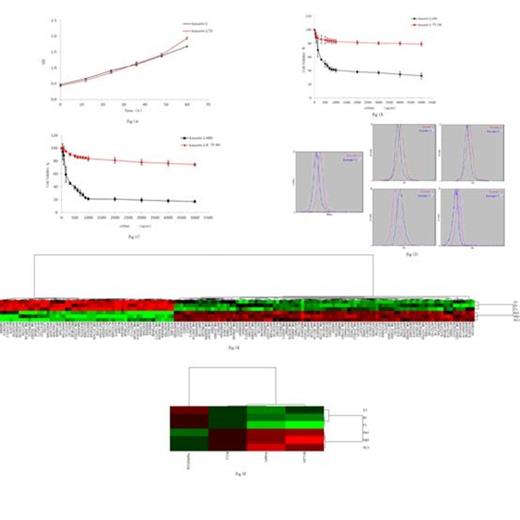Abstract
Introduction
Tumor necrosis factor related apoptosis inducing ligand (TRAIL) can induce the apoptosis of many human leukemia cells while sparing of normal cells, but its resistance is also universal. Our previous study on apoptosis of t(8;21) positive acute myeloid leukemia cell line Kasumi-1 induced by rhTRAIL showed that the survival rate no longer decreased significantly when rsTRAIL reached a certain concentration which implied Kasumi-1 cells might have a resistant tendency to TRAIL. Then, we established a TRAIL-resistant Kasumi-1 cell line (Kasumi-1 TR) by intermittently escalating rsTRAIL concentration in culture media, and compared the mRNA expression profile with the original Kasumi-1 cell line by using Affymetrix Human Genome U133 Plus 2.0 Array.
Methods
Kasumi-1 TR cell line was established by intermittently treated Kasumi-1 cells with progressively escalating rsTRAIL concentration. Proliferation of leukemia cells were measured by CCK-8 assay, and rsTRAIL IC50 of cells and resistance index were calculated according to proliferation of cells treated with rsTRAIL at different concentrations. TRAIL and TRAIL receptors 1-4 on cells surface were detected by flow cytometry. Expression profiles of Kasumi-1 cells and Kasumi-1 TR cells were analyzed by Affymetrix Human Genome U133 Plus 2.0 Array to identify differentially expressed genes, and the search of genes possibly related with TRAIL-resistance were using by GO functional analysis and pathway enrichment analysis.
Results
1) Kasumi-1 TR cells proliferation was faster than that of Kasumi-1 cells(Fig 1A); 2) IC50 of 24 hours for Kasumi-1 cells was 756.833ng/ml (logIC50 2.879 ± 0.148), IC50 of 24 hours for Kasumi-1 TR cells was 1634646.005ng/ ml (logIC50 6.213 ± 0.637), the RI of 24h was 2159 (Fig 1B); IC50 of 48 hours for Kasumi-1 cells was 345.390ng/ml (logIC50 2.538 ± 0.153), IC50 of 48 hours for Kasumi-1 TR cells was 33642.641ng/ml (logIC50 is 4.257 ± 0.317), the RI for 48h was 97 (Fig 1C); 3) Cell surface expression of TRAIL and its receptors 1-4 had no difference between two cell lines(Fig 1D). 4) There were 1537 genes up regulated by more than 2 times while 487 genes down regulated by more than 2 times in Kasumi-1 TR cells compared with the original Kasumi-1 cells (Fig 1E). Of which BCL-2 family antiapoptotic gene BCL2 is increased by 3.153 times and BCL2A1 increased by 18.23 times, IFNAR1 involved in JAK/STAT pathway increased by 12.841 times and TRAIL death receptor TNFRSF10A down regulated by 3.256 times(Fig 1F).
Conclusions: The Kasumi-1 cell line with rsTRAIL resistance (Kasumi-1 TR) is established, and its resistance may be associated with the up expression of BCL2, BCL2A1, IFNAR1 and down regulated expression of DR4.
Acknowledgment
This work was supported by grants from NSFC (30672415) and STCSM (054119528).
No relevant conflicts of interest to declare.
Author notes
Asterisk with author names denotes non-ASH members.


This feature is available to Subscribers Only
Sign In or Create an Account Close Modal